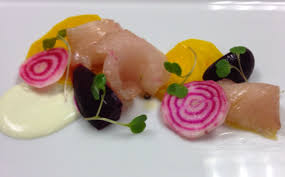by Dwight Furrow
 In philosophical debates about the aesthetic potential of cuisine, one central topic has been the degree to which smell and taste give us rich and structured information about the nature of reality. Aesthetic appreciation involves reflection on the meaning and significance of an aesthetic object such as a painting or musical work. Part of that appreciation is the apprehension of the work’s form or structure—it is often the form of the object that we find beautiful or otherwise compelling. Although we get pleasure from consuming good food and drink, if smell and taste give us no structured representation of reality there is no form to apprehend or meaning to analyze, so the argument goes. The enjoyment of cuisine then would be akin to that of basking in the sun. It is pleasant to be sure but there is nothing to apprehend or analyze beyond an immediate sensation.
In philosophical debates about the aesthetic potential of cuisine, one central topic has been the degree to which smell and taste give us rich and structured information about the nature of reality. Aesthetic appreciation involves reflection on the meaning and significance of an aesthetic object such as a painting or musical work. Part of that appreciation is the apprehension of the work’s form or structure—it is often the form of the object that we find beautiful or otherwise compelling. Although we get pleasure from consuming good food and drink, if smell and taste give us no structured representation of reality there is no form to apprehend or meaning to analyze, so the argument goes. The enjoyment of cuisine then would be akin to that of basking in the sun. It is pleasant to be sure but there is nothing to apprehend or analyze beyond an immediate sensation.
Those who are skeptical of food and drink as serious aesthetic objects base their arguments on the claim that taste and smell are inferior to vision and audition in providing us with representations of reality. Those who defend the aesthetic potential of food and drink attempt to show that food and drink do provide us with structured representations of the world.
A representation is a mental state, such as a belief, that stands for, refers to, or depicts something else, such as an object in the world. In perceptual experience, a representation specifies the way the world appears to a subject having the experience. Vision is the perceptual modality that arguably gives us the richest representation of reality. To see an apple is to locate it in space individuated from but in relation to other objects in our visual field. And that ability to locate objects is facilitated by assigning properties such as roundness and redness to the apple which appear, not as free-floating properties, but as properties bound to the object. The representation is veridical when the world is in fact as it appears in the representation.
Thus, vision does not present us with a heterogeneous heap of properties; rather properties are part of structured wholes with objects appearing as solid, individuated entities. Vision then is enormously helpful to us as we navigate through the world because it represents the spatial relations between things as well as their boundaries.
Many philosophers have argued that tastes and aromas lack essential elements of a representation. Read more »
